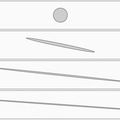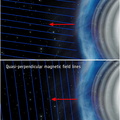
WIKIARCHIVES.SPACE
The Human Spaceflight Archive

Information
- Taken in
- Other
- Autor
- NASA/JPL-Caltech
- Descripción
- This illustration depicts the shearing of an initially circular cloud of debris as a result of the particles in the cloud having differing orbital speeds around Saturn. The numbers in the lower left of the panels in the still image show how quickly a cloud can be elongated. After the cloud is formed, each particle within it follows its own simple orbit. The cloud begins to elongate as particles closer to the planet orbit at a faster speed than the particles farther from the planet. Scientists can use the angle the clouds are canted to infer the time elapsed since it was formed. This method was used to determine the times of the impacts that created the clouds in Saturn's rings that were captured by NASA's Cassini spacecraft (see PIA14938 for more information).
- Creada el
- Jueves 25 Abril 2013
- Álbumes
- US SPACE PROGRAM / PROBES / SATURN / CASSINI/HUYGENS / Annoted/science
- Source link
- https://photojournal.jpl.nasa.gov
- Visitas
- 15
- Puntuación
- no valorada
- Valorar
- License
- Public Domain
- Modified by WikiArchives
- No (original)
- Descargas
- 1
Desarrollado por Piwigo
















































































































































































































































































































































